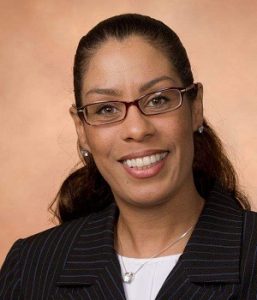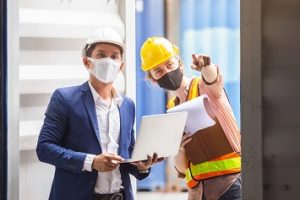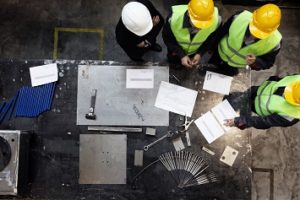Environment, health, and safety (EHS) professionals enter the field because of an innate passion for the work they do, taking pride in protecting their organization and its workers with little public recognition for a job well done. For today’s installment of Faces of EHS we spoke with Mary J. Stine, the Global EHS Director for a multinational company based in Asia, who understands that just because EHS work happens behind the scenes it does not mean that you cannot have a seat at the decision-making table. Both Stine’s career and her service in professional community organizations are a roadmap for navigating the complexities of working in EHS.
 What led you to pursue a career in the EHS field?
What led you to pursue a career in the EHS field?
I pursued my career in EHS after studying Public Health and Medicine at UCLA for the purpose of becoming a medical doctor. During my internships at the California Department of Public Health, I changed paths in health after realizing that the physical environment and occupational health conditions were one of the main drivers for most of the healthcare patients coming forward. I chose to work in this field to identify the systemic breakdowns and to incorporate a systems management approach to improve the outcomes.
What is the biggest EHS compliance challenge at your organization, and how have you managed it?
In the United States, the compliance regulations for controlled substances are quite challenging. Because most the of the manufacturing is done overseas, I have had to work with stakeholders at both ends to compare solutions and mitigate errors to avoid catastrophic outcomes. Working directly with legal helps, as well as understanding the way to communicate with the workers directly. EHS is often perceived as the “safety police” when we are really their mediator and advocate. Once they realize that is our service, they are more open to communicate and assimilate the data needed for change. A system that I have in place is to “plan, do, act, and check.” This loop helps me to prepare ahead and verify that your controls are in place.
Are there any EHS challenges unique to the work you do that could prove instructive to other EHS professionals?
The EHS officer is often a supporting role in a company. This is a service job, and you often work without recognition for your efforts. As a person who works without authority, it is most challenging to request change or even cooperation. It is like having a role that is accountable but one that cannot hold anyone else accountable.
The way that I managed this policy was by building up my skills on influence. Influence is an amazing branding tool. I used the techniques found in most marketing campaigns, which I learned at Capella University for Business. You give your target the scenario and possible solutions and give them the tools to find creative solutions. Now the idea was borne of their own making, and they begin taking pride and initiative in the project, rather than feeling they are being assigned a task. You model the behavior, and then once they see how well it worked for you, they want to control that behavior and brand it for themselves. Give them credit, and begin to coach and mentor others to do the same thing.
How has your involvement and/or service with safety organizations, such as WISE, shaped your approach to “on the ground” organizational safety?
Professional safety organizations are crucial to education and career development of the EHS officer. As of 2020, I am a Chapter Leader in two societies. I am an executive committee member of the Greater San Jose Chapter of ASSP, a board chair of WISE, and a board member of SWE. WISE is a Common Interest Group of the American Society of Safety Professionals (formerly ASSE) that supports those identifying as professionals of women in the workplace. SWE, The Society of Women Engineers, is an organization that includes members at large to foster the future interest of science, technology, engineering, and mathematics (STEM) in our global community. The knowledge base and services offered through these memberships have helped benchmark my work and allowed us to share on a virtual platform so that we are more efficient in our workplaces. The community has evolved to include virtual conferences so that we are able to meet more often and share ideas easily and in real time. This has been significant in my career exposure and activities worldwide.
Being within these organizations has been a unique catalyst for me in the recent years. Although I was a professional member since 2008, I really started to emerge in 2018 once I became a consultant. A colleague nominated me for the ChapterWise Board in 2019, and that board and the executive committee achieved Platinum Status for the first time in their history. Being able to work in your element and skill set along with like-minded individuals amplifies your effectiveness. I highly recommend joining these communities.
What do you like the most about your career in EHS?
I am most excited about the future of my career in EHS. I had big shoes to fill in our family legacy. I was encouraged to go into medicine because of my STEM background. I come from a family of civil engineers, medical professionals, computer scientists, and professional mathematicians. The initial response from my choosing EHS was that I was not very reflective of the full value of my education. Once I got into the aerospace and military industry, they became excited about it and referred to me as the “rocket scientist” for years. Now EHS is on everyone’s mind. It appears that “personal protective equipment” (PPE) are popular words. The recent fires in California and the droughts all over the world have redirected the global stage to search for help in these disasters. It is now focused on the environment, health, and welfare of the public. That forethought and planning to change lanes were correct for me, and that makes me feel that I am in the right place at the right time.
What is the most difficult or frustrating part of your job?
Being behind the scenes has both advantages and disadvantages. If you are called in to troubleshoot or investigate, you must remember to not just give them the answer. You must coach others to see the answer by asking the right questions. This can be frustrating if the person just wants you to tell him or her outright. I would say the role of EHS can be a 24/7 job. So, if you are an impatient person, it can be difficult to help people learn to work the solution as opposed to just doing it yourself. However, if you do that, then be prepared to answer the calls after hours because they forgot how to do something.
What do you see as the main emerging trends, both positive and negative, affecting the future of the EHS profession?
The role of the environment, health, and occupational safety person is the focus of 2020 and going forward because of the coronavirus SARS 2. This is the newest global pandemic frontier, and the public safety and EHS scrutiny is imminent and yet elusive to detail. For my answer, I will focus on the respiratory protection aspect, specifically the half-facepiece masks. We as EHS professionals have had to step up to the plate and demand action with regard to public education and use.
It has become the trend in fashion. I saw an ad for a designer-label face mask with rhinestones for use in public. The compliance suggestions have become slogans, and respirators have been reduced to fashion statements rather than for protective purpose.
As of September, most states do not know how to approach this or which masks are approved or compliant. To remain relevant and popular, they have relaxed standards or increased restrictions on use. It appears that each state, city, and county is doing its own thing. The future is now, and the EHS legislature is now under scrutiny. When the global leaders of health do not have a clear, consistent message to the public, the public and workers look to the consensus. That is when the EHS professionals must step in and correct the course or advocate for legislation to augment policies to remain compliant. The future is in our hands. We are trained to understand the technical aspects and limitations of the PPE and environmental controls. We have sided with medical professionals to indicate the disparity in training and industry approval and put out placards of proper use techniques and videos.
It is positive that people want to be healthy and protect themselves and others. It is a positive slogan to say wearing a half-face mask shows that you “care” and it is a sign of “respect.”
However, it is negative if you are not well-informed of the risks of improper use, placement, and hygiene procedures. If anything, to just wear for fashion and not function defeats the purpose, in my opinion. There is much more to build on here, but in my focus, that is an ongoing challenge of supply and effectiveness in controls.
COVID-19 continues to have a dramatic impact on businesses of all shapes and sizes. Do you feel that your organization was well-prepared for the challenges posed by the pandemic?
Yes, all businesses have been both financially and logistically affected. Brick-and-mortar buildings are becoming obsolete, and virtual platforms are crashing under massive traffic use.
Most Fortune 500 companies are well-prepared and -versed in business continuity. Back in the early part of this decade, we set in place systems for management of pandemics and events such as structural fires, earthquakes, and loss of critical supply vendors. We were prepared to manage the avian flu and SARS-1. However, the combination of government legislature, public health campaigns, and critical compliance limits on PPE has made this strain of virus most challenging.
Our preparation is evolving daily based on the regulatory reports and levels of damage and consequences of exposure. Our leading information is constantly changing. The symptoms are constantly being updated, and the people management roles are being told opposing directions of how to record the active cases for occupational exposures.
It was difficult to identify a baseline to show a goal and milestone when the indicators kept moving. The supplies were limited to address; activate response systems; and manage waste control, PPE, and isolation. New programs that were developed with solutions on social distancing software have been an IT and operations nightmare. We were prepared for a static, short-term pandemic, yet this has evolved into more than an office or a manufacturing facility location.
As the EHS director for a multinational corporation, how have you dealt with the differential impacts of the pandemic as it spread to different regions where you have facilities?
As a director, I can go and come as I please in any client organization. I can interview at 6 feet without issue or via webcam or by phone. I can audit a facility with a drone cam and software. My limited interactions are during travel and set up in an organization.
For local workers, the administration staff protocols are in place to use Lean Six Sigma 6S daily on schedule before and after work to adhere to hygiene and occupational safety and health (OSH) compliance. In the manufacturing workforce, they are largely socially distanced in activities and using Lean Six Sigma in marked locations and operations. It requires a new rotation of stationed activities and the evaluation of software to observe the distances to avoid cross-contamination. The cost is prohibitive, and the social impacts have affected many people. Some have left employment to care for loved ones. Most are depressed because of the loss of connection, communal lunches, and loss of facial recognition cues, and their motivation to safety is more of a compulsion than a measure of comfort.
In what ways has the pandemic shifted your perspective on managing EHS requirements for a multinational organization?
Large-scale operations tend to be a one-size-fits-all for most rollouts or management system changes. This pandemic was not limited to the office or workplace. It has encroached into the homes and outdoor activities of every person who can comprehend this event on the planet. I would be wrong if I said that I had the magic key to unlock the door to this solution. Past efforts had to change, that is for sure.
A lot of my clients have instituted a real-time desktop or phone application through Microsoft Teams. This dashboard will install a landing page on the website to update offices on what the current protocol is for COVID-19 as a webpage. It has a log-in user-based interface that allows for a self-reporting page, options for track and trace, and self-isolation applications on your phone with the newest iOS13 update. The second phase was returning to work. This involved the recognition of local authorities’ interpretation of requirements, as I mentioned earlier, and we augmented that with the highest level of protection for our employees to benchmark compliance. The self-check mirror thermometer at the door, hand-held wands for those in commerce, and the limited-access badges for nonessential employees for sections are in effect. There is no cross-contamination when an isolated employee wants to wander to another floor because it has better lighting. Once your badge assay has been updated to active, you can travel your evacuation routes only, complete the day in isolation, and then quarantine at home.
For out-of-office affects, we have employee assistance programs and services to help return-to-work employees adjust and manage attrition rates. We meet regularly with people and legal services to understand our risk tolerance and identify a baseline of expectation and set goals to reduce the incidents to zero.
What is your favorite job-related story that you like to tell others?
I am a calculated risk-taker. I am also amazingly comfortable in unfamiliar situations. I tell others that when you get an opportunity that has a high yield and moderate risk, take it.
Early in my career, I would say my experience in building a 310,000-square-foot concrete facility for $15 million was thrilling. I was selected as the PM because of my analytical skills and ability to influence. The story goes that the company had been trying to build a new facility for many years without success. Then when I came to the company as an EHS coordinator through Apollo Engineering Solutions, I thought it would be a 3-month contract. I analyzed the program gaps, did a hazard assessment, and revolutionized the EHS program. I was hired after the 3 months was up. I went on to start programs that saved millions on insurance and liability, reducing the X-Mod, becoming self-insured, and on and on. I had only been there a year when the CEO hired me and promoted me three times up to risk manager. I had earned his trust over the years, and one day, he challenged me to build his dream building. I did not know the history of the project, but I had built up enough connections to do the job, so I agreed. Before I knew it, I was side by side with the facilities manager leading this quest and finally realizing why this had not worked before. We worked as a team to build relationships and to mend burnt bridges across the councils and planning committees. The critical point was after plans review through redevelopment and the public notice. I was invited to attend and dressed up for my first council meeting in my life. I was so surprised as I arrived and took a seat when the CEO came over to my chair and said I was asked to speak on behalf of the entire corporation before a city council to approve the build. I looked over at the facilities manager, and he was as surprised as I was. So, in the next 10 seconds, I was announced and standing at a podium, looking at the council and the community. I knew my work was sound, but I was gripped with the fact that this was now my responsibility. The CEO trusted me, a rookie, to take this risk, and if I failed, they would probably try again but not with me. I had to do my best to make sure it worked. I was fielding angry comments and resolving arguments from locals who did not like the CEO or his business. I spoke with compassion about the benefits of the event. I completed the proposal, answered the questions, and then gained the approval. My initiation into my career was that I was an advocate for the community to build jobs and to sustain the grandfathered air permits within the company while saving money on the structural build. I still cannot believe I was a part of that. The building is at 1462 East 9th Street in Pomona, California. It is a spectacular LEED-efficient structure that employs up to 1,200 staff.
What advice do you have for people just entering or transitioning into the profession?
This career is not a trend or a fad. This is a lifestyle. Your requirement and commitment to this profession are not only ethical but also tantamount to your character. You should accept that you will not always be right; you will not always have an immediate answer despite the boss demanding that you do. To influence change, you must first build your credibility. Realize that life and limb are at stake in your position, and to institute compliance, you must first earn their trust and have an established character.
If you are open to challenges and constantly changing environments and are prepared to work independently to drive success, then you have what it takes to endeavor in this career and thrive.
If want to grow an excellent reputation in this field, please consider The Four Agreements from Don Miguel Ruiz:
- Be impeccable with your word.
- Do not take things personally.
- Do not make assumptions.
- Always do your best.
| Mary J. Stine, MS OSH, ASP, has detailed experience in the Occupational Health, Safety field, including 10 years in Environmental Compliance. She attended UCLA and Pennsylvania State University to being a career in Psychiatric Medicine with an emphasis in Pharmacologic studies. She then migrated into Occupational Health and Emergency Management for Military Defense and Aerospace work at UTC which contributed to actions for the US International Space Station (ISS) and Military.
Mary was awarded internships with UCLA and The California Public Health with project concentration on Pathology and Pharmacological vigilance. Actively involved in Technology – She co-engineered a patent for Y2K serial encryption routine for up to 2 centuries worth of data compilation and was awarded 48 points for royalties. Mary is now the Global Director of EHS Programs in Asia| EU | USA. |

Would you like to be profiled in a future Faces of EHS and share your experiences, challenges, etc.? Or, do you know anyone else in EHS you think has an interesting story to tell? Write us at jscace@blr.com and cdouyard@blr.com and include your name and contact information; be sure to put “Faces of EHS” in the subject line.




